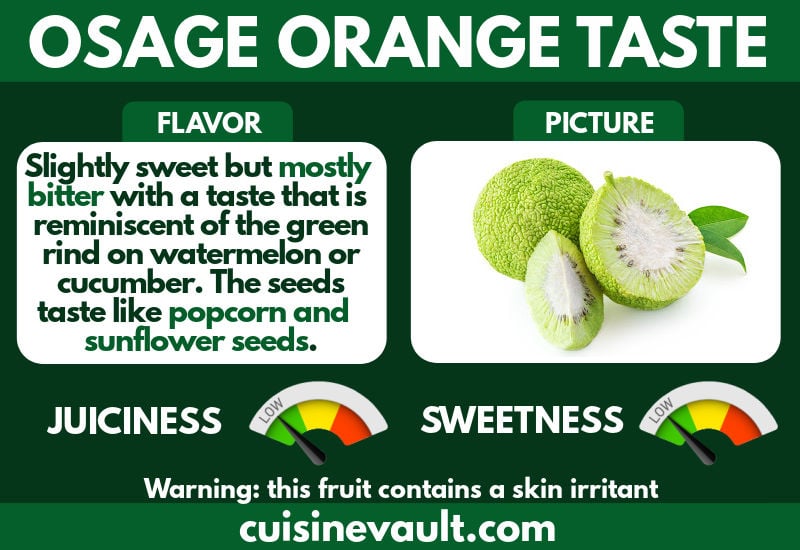Osage orange trees can be found throughout the United States and southeastern Canada. They are commonly trained as a hedge along boundary lines and the fruit wards off unwanted pesky insects. If you'd like to know what an Osage orange tastes like, then keep reading. We’re about to look at this fruit’s flavor, texture, and whether it's worth eating.
Food safety warning: before you rush out and slice into an Osage orange, keep in mind that there is a skin irritant contained within this fruit. Eat this fruit at your own risk.
What does an Osage orange taste like?
The Osage orange contains flesh that is overwhelmingly bitter with a touch of sweet; its taste is reminiscent of the green rind on watermelon or cucumber. The fruit has a sweet aroma of nectar mingled with citrus and its texture is dense and stringy.
Most people find the pulp of an Osage orange to be unpalatable while others feel ill after eating it. We conducted a poll on one of our social media cooking groups asking people whether they had tasted the fruit. Of the thousands in the group, only eight had actually tasted this ingredient and none of them would eat it again.
The unpleasant flavor combined with safety issues points to the fact that this is one of those foods that is best left alone.
Although the flesh of an Osage orange is practically inedible, the seeds are considered better eating. Once the fruit is sliced in half, there are roughly 200 to 300 light brown seeds on offer. After roasting, they have a slightly bitter but pleasant taste, a cross between popcorn and sunflower seeds.
 How to eat osage orange seeds
How to eat osage orange seeds
We strongly suggest wearing gloves to keep the irritating sap from touching your skin.
- To get the seeds from an osage orange the fruit should firstly be sliced in half and then cut into smaller pieces.
- Half fill a large bowl with cold water and then add the pieces of fruit.
- Leave the bowl standing on the counter for 24 hours; this allows the fruit to soften, making it easier to extract the seed.
- Drain the water and begin picking the seeds from the fruit, ensuring that you are wearing gloves. Once you have enough seeds, place them on a paper towel on a plate and allow them to dry thoroughly.
- Add the seeds to a lined oven tray and splash with olive oil and a sprinkle of salt. Roast for 15 minutes at 300°F, turning halfway through.
- Eat the seeds once cooled or store refrigerated in an airtight container.
Is Osage orange worth eating?
Most people will find the flesh from an Osage orange isn't good for eating. It also has a skin irritant in its sticky latex-like juices, so we recommend avoiding this food.
While the seed is edible, the amount of work required to extract them probably isn't worth your time. You may want to try them once just to say you've tasted them, but there are plenty of more enjoyable foods on offer that are much easier to get access to.
This fruit is better used as an ornamental decoration or an air freshener which will last for two weeks if stored in a cool dry place.
Related reading:
How does a jackfruit compare to a durian?
What does a soursop taste like?
What does a breadfruit taste like?
Fast facts about Osage oranges
- They have many alternative names including monkey brains, hedge apple, bodark, horse apple, and monkey balls.
- The fruits are globular and usually average 3 to 6 inches in diameter. They are a yellow-green color and have a rough surface with the occasional hair.
- The tree was a popular hedge plant up until 1874 when barbed wire took over as the preferred fence.
- It grows everywhere in the Midwest and was the most intentionally planted tree within the US. In other parts of the world like Italy, it is considered an invasive species.
- The scientific name for Osage orange is Maclura pomifera and is a member of the Moraceae family. It is related to the Mulberry.
- The wood from this tree is hard and Native American tribes would traditionally use it to make bows and other weapons.
- Alexandria, Virginia is home to the largest known Osage orange tree. It is believed that Thomas Jefferson provided it as a gift.
Interesting reading:
How much juice comes from one orange?
How can I freeze oranges?
How do I replace orange marmalade in cooking?
Summing up
When reviewing fruits on this website, we usually find at least one redeeming feature about them. In the case of the Osage orange, we couldn’t find anything worthy of mentioning, sorry. It is a useful tree for a variety of reasons, but food isn’t one of them.
The seeds were okay, offering a flavor a cross between popcorn and sunflower seeds. But the painstaking process required to remove them from the fruit wasn’t worth it. But that’s just our opinion.
Are you seriously considering tasting an osage orange? Please let us know in the comments.

Leave a Reply